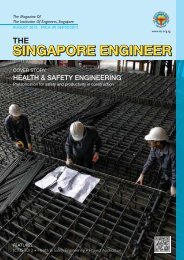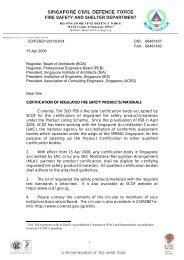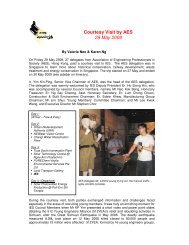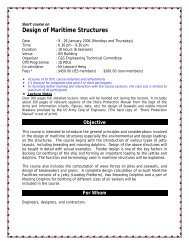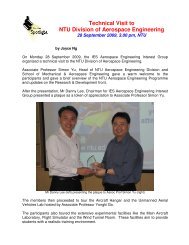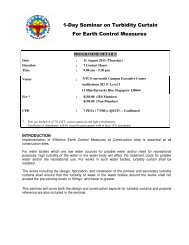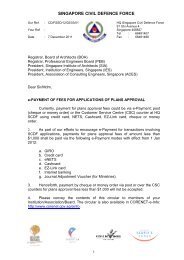THE SINGAPORE ENGINEER - Institution of Engineers Singapore
THE SINGAPORE ENGINEER - Institution of Engineers Singapore
THE SINGAPORE ENGINEER - Institution of Engineers Singapore
Create successful ePaper yourself
Turn your PDF publications into a flip-book with our unique Google optimized e-Paper software.
AEROSPACE COVER <strong>ENGINEER</strong>ING<br />
STORY<br />
detection <strong>of</strong> corrosion and the detection <strong>of</strong> defective parts in<br />
the aircraft. The early corrosion detection system can detect<br />
surface cracks measuring less than 1 mm. The defect detection<br />
system is capable <strong>of</strong> detecting disbond, delamination and impact<br />
damage in composites. With rapid scan rates <strong>of</strong> 0.06 m/min - 1.2<br />
m/min, non-visible surface cracks can be detected reliably and<br />
accurately, minimising potential downtime.<br />
In applying millimetre wave technology for both systems, there<br />
are a number <strong>of</strong> advantages.<br />
• The millimetre wave techniques are in real-time, fast, and contactless.<br />
• They have the ability to detect cracks under paint coatings.<br />
• They do not require a couplant to transmit the signal into the<br />
material under test (unlike ultrasonic methods).<br />
• Millimetre wave is capable <strong>of</strong> penetrating most non-metallic materials.<br />
• Millimeter wave systems are capable <strong>of</strong> producing robust<br />
inspections and can be manufactured for small, handheld, and<br />
inexpensive devices.<br />
• These systems use low microwave power (1 mW - 10 mW).<br />
ELECTRONICS AND COMMUNICATIONS<br />
SOI-CMOS Integrated Circuits for operation up to 300˚C<br />
Many industries such as oil exploration, aerospace and automotive<br />
require electronic circuitry that operate at high temperatures.<br />
To address these needs, the Rugged Electronics Programme<br />
<strong>of</strong> A*STAR’s Institute <strong>of</strong> Microelectronics (IME) develops<br />
sensor interface electronics that can reliably measure various<br />
physical parameters at temperatures <strong>of</strong> up to 300° C and at<br />
environmental pressures <strong>of</strong> up to 30 Kpsi.<br />
IME researchers are exploiting the low leakage current feature<br />
<strong>of</strong> the Silicon On Insulators-CMOS process to develop circuit<br />
devices that can work at temperatures up to 300° C. IME‘s<br />
new approach will address the limitations <strong>of</strong> conventional Metal<br />
Oxide Semiconductor Field Effect Transistors, to enable high<br />
resolution sensor interface circuits that can deliver critical data<br />
in harsh environments.<br />
Non-volatile memories for aerospace applications<br />
On-board applications in aircraft, such as in-flight entertainment,<br />
have increased the demand for high performance electronics. Thus,<br />
there is more reliance on electronically driven systems and extensive<br />
sensor networks <strong>of</strong> structural health monitoring (SHM) systems.<br />
The application <strong>of</strong> high-performance electronics allows for<br />
condition-based repair and maintenance <strong>of</strong> some aircraft<br />
components. By utilising integrated damage monitoring systems,<br />
it could decrease the cost <strong>of</strong> repair and maintenance by 20%.<br />
To fully realise this advantage, the memory needed for such<br />
applications should possess these key properties - large memory<br />
capacity, ability to operate at high temperatures, ability to lower<br />
power consumption, and radiation resistance. But current<br />
memory devices, which are based on flash and Static Random<br />
Access Memory technologies, tend to perform poorly.<br />
A*STAR’s Data Storage Institute (DSI) has developed the next<br />
generation <strong>of</strong> non-volatile memories - Spin Transfer Torque-<br />
Mangetoresistive RAM (STT-MRAM) and Phase Change<br />
RAM (PCRAM). The technology aims to achieve low power<br />
consumption, heat resistance to operate up to 200° C, radiation<br />
resistance for high-altitude environments, and high operability<br />
and reliability; and to ensure feasibility <strong>of</strong> non-volatile memories<br />
as well as deliver fabrication techniques. Importantly, it aims to<br />
provide the error correction codes that are specially designed<br />
for memories that are exposed to high temperature and high<br />
radiation environments.<br />
STT-MRAM and PCRAM technologies are two core competencies<br />
that DSI has developed, with more than 30 patents filed.<br />
High reliability package for harsh environments<br />
Aerospace control is vital and requires very high reliability. The<br />
current aerospace control system uses electrical signals instead<br />
<strong>of</strong> the bulky and heavy but robust hydraulic controls. In order<br />
to be cost-effective, the aerospace industry has been switching<br />
to <strong>of</strong>f-the-shelf components. These commercial electronics<br />
components however are not designed to meet the long-term<br />
high reliability requirements beyond 150° C. The selection and<br />
development <strong>of</strong> materials for high temperature environments<br />
therefore poses a formidable challenge.<br />
To mitigate this problem, the package design should not only<br />
integrate and provide interconnectivity for the electronic devices<br />
but should also provide mechanical and thermal protection from<br />
harsh environments without compromising on performance.<br />
This requires electrical, thermal and mechanical design to meet<br />
the operating requirements.<br />
A*STAR‘s IME has looked into developing an electronic driver<br />
circuit package for supplying the electrical power for the aircraft<br />
braking system. The focus is to develop a high-performance<br />
packaging platform that can endure in harsh environments. This<br />
involves inter-connection, metallisation and protective coating,<br />
and the selection <strong>of</strong> the appropriate material for the coating, die<br />
attaching and metallisation to achieve the operating requirement.<br />
In addition, this includes the design <strong>of</strong> the process flow and<br />
assembly for the forming <strong>of</strong> the reliable interconnects for the<br />
package. The package is expected to use conventional industry<br />
packaging technologies and organic printed circuit boards, which<br />
can help to achieve a cost-effective solution.<br />
The project will develop mechanical, thermal and electrical<br />
packaging design rules for a multi-chip module package. It will<br />
also explore and evaluate electrical integrated passive circuits<br />
for the driver package.<br />
Next generation cabin communication platform<br />
In-flight entertainment and communication services are fast<br />
gaining importance for airline operators in their bid to attract<br />
customers by providing the best possible services. However the<br />
size, weight, and power constraints on aircraft systems, coupled<br />
with rapid advancement in and the multitude <strong>of</strong> communication<br />
and entertainment technologies mean that traditional methods<br />
<strong>of</strong> dedicated systems for each supported technology are no<br />
longer efficient.<br />
20 <strong>THE</strong> <strong>SINGAPORE</strong> <strong>ENGINEER</strong> April 2012



